Apple's 2010 MacBook Air (11 & 13 inch) Thoroughly Reviewed
by Anand Lal Shimpi on October 26, 2010 10:08 PM EST- Posted in
- Mac
- Apple
- MacBook Air
- Laptops
The SSD: Not Half Bad
Apple advertises the new MacBook Air as being instant on as a result of the internal SSD. That’s mostly untrue. From a completely powered off state the MacBook Air still takes time to boot. That time is significantly reduced compared to the old MacBook Air and any other Mac with a conventional hard drive. It’s even a shorter boot than my MacBook Pro with a SandForce SF-1200 based SSD in it:
| System Performance Comparison | ||||||
| Boot | Shut Down | Sleep | Awake | |||
| 11-inch MacBook Air | 15.5 seconds | 2.2 seconds | 1.0 second | 1.63 seconds | ||
| 13-inch MacBook Air | 14.4 seconds | 1.9 seconds | 1.0 second | 1.56 seconds | ||
| 13-inch MacBook Air (Late 2008) | 34.4 seconds | 2.9 seconds | 1.6 seconds | 4.19 seconds | ||
| 15-inch MacBook Pro (SF-1200 SSD) | 19.1 seconds | 1.8 seconds | 1.5 seconds | 2.3 seconds | ||
| 15-inch MacBook Pro (Mid 2009, HDD) | 34.2 seconds | 2.8 seconds | 1.8 seconds | 2.1 seconds | ||
You'll notice that even the SF-1200 SSD in my 15-inch MacBook Pro takes longer to boot than these new Airs. Apple does customize the firmware on its SSDs. I’d be willing to bet the SSD in the MacBook Air has tight integration with OS X to guarantee quicker than normal boot times.
Clearly the new Air isn't instant on from a boot standpoint, but it's pretty much there from a recover-from-sleep standpoint. The new Airs both go to sleep and wake up from sleep quicker than any of the other Macs, including my upgraded 15-inch Core i7 MacBook Pro. Again, nothing can trump Apple's tight integration between hardware and software.
Apple likes to work with two different controller manufacturers for SSDs: Samsung and Toshiba. iFixit already confirmed Toshiba is in the new MacBook Air with its teardown:
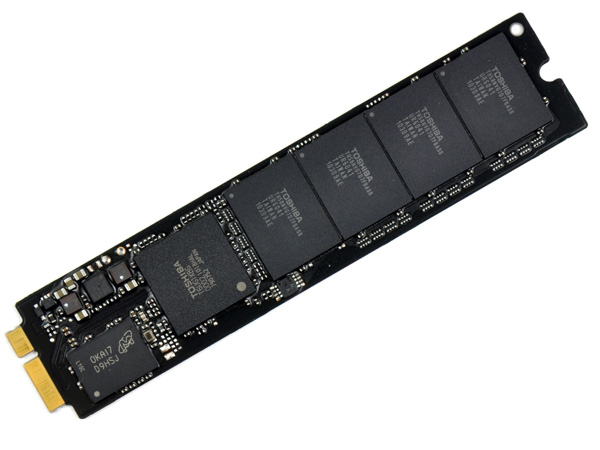
The 11-inch MacBook Air SSD, courtesy of iFixit
The SSD isn’t in an industry standard form factor, although the connector appears to be either micro or mini SATA. Presumably 3rd party SSD manufacturers (ahem, SandForce partners I’m looking at you) could produce drop in replacements for the MacBook Air SSD.
There’s nothing particularly innovative about the form factor of the SSD, other than Apple did away with the unnecessary space a 2.5” SSD would require. Just as SSDs will break the traditional SATA interface barriers, we’ll see the same happen to form factors as well.
The part number on the Toshiba controller may look familiar to some of you. It’s the same controller that’s in Kingston’s SSDNow V+ Series and the SSDNow V Series Boot Drive. I reviewed the latter not too long ago and found that it was a good drive for the money, and here’s the kicker: the SSDNow V Series Boot Drive was amazingly resilient when written to without TRIM support. Its performance hardly dropped as a result of normal desktop use. This is very important because although OS X 10.6.4 has a field for reporting TRIM support on an SSD, the instruction isn’t actually supported by the OS. Even the new MacBook Airs don’t ship with a version of OS X with TRIM support.
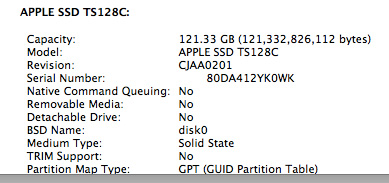
The SSD only has four NAND devices on it. Typically that would mean some very low transfer speeds, particularly on writes. But each one of those four devices has at least 16GB of NAND, spread across multiple planes and die. With the right firmware, you should be able to extract a good deal of parallelism from this architecture. Apple and Toshiba apparently do just that.

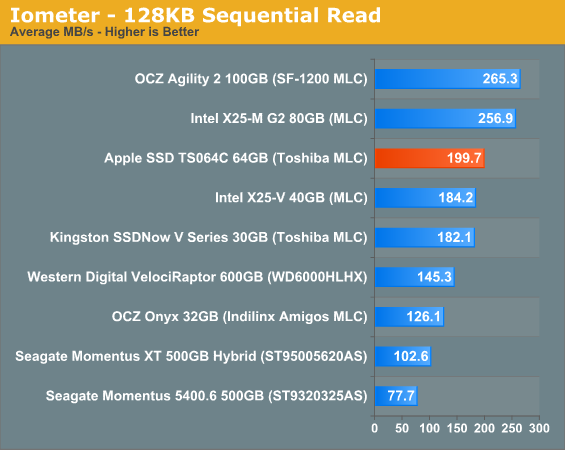
While most value SSDs top out at under 100MB/s, we get nearly 200MB/s sequential reads and writes out of the SSD in the new MacBook Air. And fortunately, Apple hasn’t only focused on sequential performance. The random read/write performance of the new MacBook Air SSD isn’t terrible:
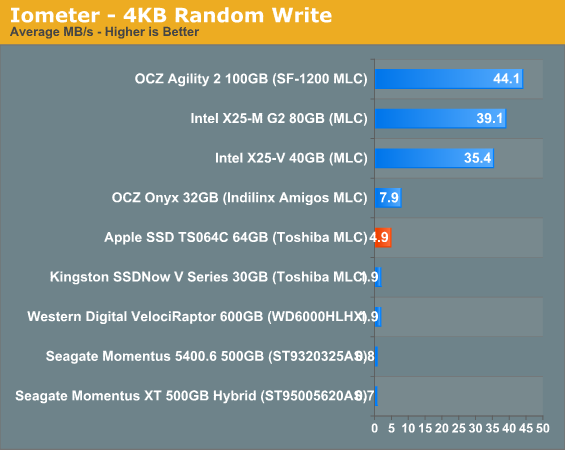
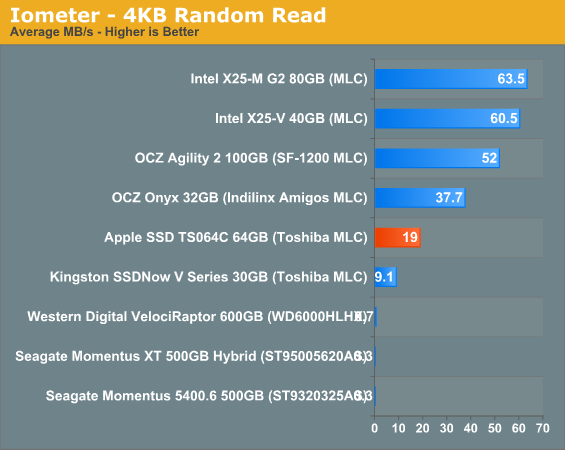
Random write performance is of course the weak point, but you’ll notice that it’s actually higher than the Kingston drive that uses the same controller. While Apple would’ve been better off striking a deal with Intel or SandForce for the controller in the MacBook Air, the Toshiba controller isn’t horrible.
As I mentioned earlier, resilience is very important as OS X still doesn’t support TRIM. I filled the drive with garbage and then tortured it for 20 minutes with random writes. The resulting performance drop was noticeable, but not unbearable:
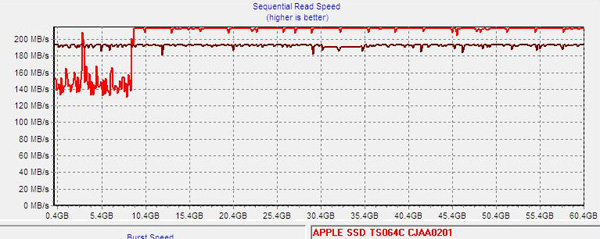
A single pass of sequential writes restores performance to normal:
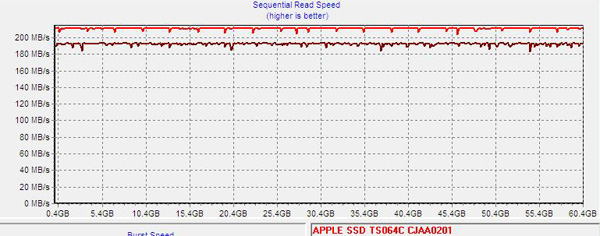
This tells us two things. First, through normal use the drive should be able to recover its performance over time (assuming you give it enough spare area). And second, if there’s any idle garbage collection in Apple’s custom firmware for the Toshiba controller it should be able to keep the drive running at peak performance even without TRIM supported in the OS. I don’t have a good way of measuring whether or not there’s GC enabled on the drive in OS X, but I suspect Apple is (at least it appears to be doing so on the Mac Pro’s SSDs).
Overall I’m pleased with Apple’s SSD selection. It could’ve been a lot better but it could’ve been a lot worse. The MacBook Airs in their default configuration have better IO performance than any other standard config Mac sold on the market today, including the Mac Pro.










185 Comments
View All Comments
quiksilvr - Wednesday, October 27, 2010 - link
The answer:Combined, they will be much less than $800.
THe BRD is an option to add-on, so generally speaking, the normal trend is ~50% higher than the cost for the manufacturer to purchase and install it.
And they can use ANY LV, ULV chip. Start at the lowest and give options for US to choose how high we can go.
The design obviously will be altered somewhat for the ExpressCard slot, but the more I think about it, the more unnecessary it is in this day and age. USB 3.0 will give the speeds. (Also, USB 3.0 controllers aren't ZOMG expensive, they are relatively cheap)
And its not 11, 13, and 15, its 11.6", 13.3" and 15.4" (and 17"). Seriously, 12", 14" and 16" is the best. You hit all three markets: the ultraportable, the general usage, and desktop replacement.
And finally: stop being a douche and lets have a debate rather a name calling contest. Seriously, you wasted a run-on sentence on TARDIS and TARD?
solipsism - Wednesday, October 27, 2010 - link
Again, you've failed to even do the most rudimentary of research or cognitive thinking but somehow came to an $800 retail price point.Intel list their price per 1000 units of LV and ULV chips, and other vendors do sell 9.5mm BRDs (though not the more expensive slot-loading drives, as far as I can tell), and those two items alone are about $800. That's only two components and doesn't include any other costs or a profit margin.
Then you've ignored Apple's choice to focus on slim deaigns. You may not like it (I certainly don't as an 11" MBA with double the battery would be more ideal for my needs) but you need to accept it. Saying "they don't have to make their machines so thin" is a strawman argument so don't even go there.
Seriously, trying looking at actual HW on the market that Apple would potentially use, then price it. Grabbing a price for adiaplay base solely on resolution is pointless. Grabbing a price of a BRD that doesn't fit the space is pointless. Conclusion, your response will likely be pointless.
quiksilvr - Wednesday, October 27, 2010 - link
*takes deep breath*...A Blu ray drive OPTION (NOT STANDARD). The customer will pay for it if they so choose and there are slot load blu ray drives out there from Panasonic, Sony and even Dell.
They don't have to be 9.5 mm they can be 12.7 because the Macbooks (not the Airs, which will not have an optical drive) are ~25 mm thick.
And the slot load Blu Ray DRIVES run for ~$100:
http://www.google.com/products/catalog?hl=en&q...
The slot load Blu Ray BURNERS run for around $250:
http://www.dectrader.com/466803-001-New-HP-4X-Blu-...
So to maintain profits, they would charge $150 for the drive and $350-$400 for the burner.
As for LV and ULV, the most expensive chip I found (ULV cost more than LV) is the Core i7-680UM which runs $317 (if you buy 1000, which I'm sure Apple can afford):
http://ark.intel.com/Product.aspx?id=49664
I think it will be safe to assume (unless you object otherwise) that the ultra low voltage Core i3s and i5s will be noticeably cheaper.
I don't spout out statistics because the information is quite literally a Google search away. I LITERALLY wrote "slot load blu-ray drive" and got those retailers.
quiksilvr - Wednesday, October 27, 2010 - link
Sorry, wrong link. The Blu ray BURNERS cost around ~$350 (damn, no wonder retailers don't sell these in laptops)http://www.amazon.com/DIGISTOR-Blu-ray-Burner-Slot...
So to make it marginally profitable, it would be ~$450-$500 to ADD onto the BASELINE Mac product.
solipsism - Thursday, October 28, 2010 - link
OMG! This guy actually posts a link to a desktop-grade BRD that costs over $350 and suggests it for a Mac notebook that can only take a 9.5mm ultra-slim drive!SERIOUSLY, WTF IS WRONG WITH YOU?!
You have ignored my list of sensible questions to you regarding viability and psychics, and have nonsensically claimed that Apple doesn’t use quality components when even AnandTech, one of the most neutral tech sites around clearly show that the LCD, trackpad and many other aspects are better than the competition.
Look, you don’t have to like a company or their products, but to allow a modicum of common sense into your posts when you claim to be the only sensible one posting is insane. Really, it’s fraking crazy!
quiksilvr - Thursday, October 28, 2010 - link
Siiiiigh.If you clicked the third image, you can clearly see that the HOUSING is what is 43mm and not the drive itself. You can actually see below the connector all that empty space under it.
And things like the trackpad and LCD (especially on 11 and 13" screens) are not much more expensive (do you really want to go through every single minute component just so I can prove to you that it doesn't even come close to the costs I suggested?)
I showed the pricing of the ULV and LV chips are (or at least what the absolute maximum will be for the one that the customer will pay extra for), it has already been established that the RAM, the memory, the screen and the GPU are available on other products for less, and I showed you the Blu ray Drive (the oh so fancy slot one that people want) that ISN'T EVEN STANDARD ON THE BASELINE I RECOMMENDED.
I don't like the company because the company's pricing doesn't make sense. Yes the unibody aluminum is great. I like solid construction. The weight and thinness isn't really a big deal for me, but that doesn't negate the fact that it costs extra and takes effort.
Should Mac products cost more? Of course. But the extent of their pricing lacks common sense and the only reason they are selling so damn well is because consumers have been brainwashed by their marketing tactics and "trend" setting. It makes me sick to my stomach that such a company has made $51 billion dollars over these products.
darwinosx - Tuesday, November 2, 2010 - link
You are not factoring in their far superior service, which cost money, their higher hardware quality control standards, which costs money, the fact that they write their own OS instead of just slapping whatever mediocrity Microsoft is slinging these days, their own hardware design, higher quality hardware manufacturing, or the fact that you are clueless.ImSpartacus - Wednesday, October 27, 2010 - link
I don't think Apple can make those kinds of prices. There are a lot of things that go into a macbook that just aren't found in other laptops.-Giant trackpad
-Decent LCD
-Large battery
-Exceptional build quality
When you cram superior laptop components into a smaller package, it will undoubtedly be more expensive.
darwinosx - Tuesday, November 2, 2010 - link
You have no idea what you are talking about. Back to Mommy's basement.tim851 - Wednesday, October 27, 2010 - link
>>I know this will never happen because it makes too much senseGotta love it when somebody comes along and makes a "more sensible" pricing suggestion to the far and wide most profitable PC hardware manufacturer in the world and the gist of it is: price it more like those competitors that outsell you but earn less money doing it.
You're a genius! You should make the same suggestion to Ferrari: Guys, you can move a whole lot more cars if you just make them cheaper!
For ten years people have been saying that Apple needs to get cheaper. All the while they became ever more successfull. They might technically not be the no.1 computer maker, but they have a higher net income than the rest of the top 10 (probably even top 20) COMBINED. So the last thing they need to do is make their stuff cheaper.